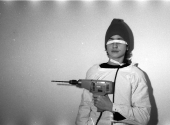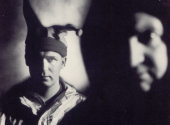
Milestones in Music History #46: Nine Inch Nails, The Upheaval of Post-Metal
The wave of sonic freshness brought by Jane's Addiction, the protagonists of our last episode, did not go unnoticed. But music has always also been an expression of inner dissent – of fears and complications of the soul. Therefore, the path of alternative rock has not always followed the same path and some have preferred to privilege its more intimate, somber traits, letting themselves go into a downward spiral. And so it was that modern rock turned black with Nine Inch Nails.
It is interesting how, in the same years of their formation, two bands can take a completely different approach to a genre – and revolutionise it, creating something completely new and inspiring. Jane's Addiction took the L.A. sound totally to another dimension, ushering in modern rock, unpretentiously but arrogantly – and deservedly so. Others, however, probably due to a more introverted nature perceived modern rock in a different light.
But this was probably also due to the different spatial locations. Indeed, if we move from Los Angeles to Cleveland, Ohio, the situation is quite different. Located on the maritime border between the United States and Canada, the so-called Forest City overlooks Lake Erie and is a port city but enjoys a far less favorable climate than L.A. and its sultry beaches. A place fit for soul-piercing sounds.
Perhaps for this reason jazz was preponderant in Cleveland since the 1930s. Art Tatum performed regularly in the city's clubs in those times, and in the years that followed major jazz figures performed there, among many others Dizzy Gillespie, Django Reinhardt, Duke Ellington and Artie Shaw. Curiously, another successful genre in the 1950s and 1960s was the polka, which here in Cleveland was elevated to a subgenre, the Cleveland-style polka, which Frankie Yankovic, considered 'America's Polka King', is the most shining example.
Trent was born a little further inland, in the small town of New Castle, Pennsylvania, just under 100 miles from Cleveland. But the small-town environment clung to him from an early age. The first instrument he picked up was the piano, and during the first concert of his life, that of the Eagles in 1976, he decided he wanted to do that, to be on a stage.
So, at Mercer Area High School he learned the saxophone and tuba and began playing in the school's band and jazz group. Also, while in high school, he joined the local band Option 30, with whom he regularly played three shows a week. After finishing school, he enrolled in engineering, in Meadville, Pennsylvania, but after a year of college, he finally decided to devote himself body and soul to music and left for Cleveland.
Once settled in, Reznor joined several local bands, first the Urge, then The Innocent as keyboardist, but after three months he left this band as well to join the Exotic Birds, with whom he performed under a different name, The Problems, in the 1987 film Light of Day. Also, during this period, he collaborated with the music group Slam Bamboo and the new wave band Lucky Pierre.
But the turning point came when Trent Reznor was hired as a janitor and assistant engineer at Cleveland's Right Track Studio, where he had the opportunity to use the studio for free while it was unused. So, he began working alone on the very first Nine Inch Nails material, and on Prince's inspiration, having found no worthy members to join the project, he did it all himself, adding only the drum machine for the rhythm parts.
Shortly thereafter Trent Reznor made his first live appearance (at the Phantasy Theater in Lakewood, Ohio, in 1988) with his solo project, Nine Inch Nails (often abbreviated as NIN and stylised as NIИ). Many assumed it was about the length of the nails that pierced Jesus Christ, others that it was for Freddie Krueger's nine-inch nails.
But this isn't as important as the fact that once the demo was finished at the studio where he worked, Trent moved on to sequencing, done with a Macintosh Plus. Furthermore, he made use of synths such as the classic Prophet VS, the Minimoog, the Oberheim Xpander and the E-mu Emax. The latter was used because it made a buzzing noise when he transposed the sounds down. The result was a great.
Pretty Hate Machine, released in 1989 by TVT Records (even though Reznor signed to Interscope Records soon after), was a biting spin on soul-twisting melodies; it recalls industrial and there is some touch of metal, but the rhythms are electronic music, and the singing cannot be categorized. It goes beyond everything and is the synthesis of everything that was going around in those years, with an added touch of "hate", and the use of samples from some of his favorite artists.
Apart from Prince, also Jane's Addiction (you can hear some notes of "Had a Dad" in "Ringfinger"), and Public Enemy. A poignant, emotional, and angry record, with absolute peaks of musical bravura in pieces such as the opening track "Head Like a Hole", "Down in It" and the epochal and dreamy "Something I Can Never Have", a song which Loren Coleman said was about themes related to suicide.
The year following the release of the album, NIN went on a long tour, which ended with the band's participation at Loolapalooza in 1991. The band thus moved to Los Angeles, but not just any place, but Benedict Canyon, 10050 Cielo Drive, the infamous residence where the Manson "family" killed Sharon Tate and four of her friends, a residence renamed by Reznor with the name "Le Pig".
Here NIN began recording the band's second work, released in 1992 with Interscope, the EP Broken, which reached the top 10 on the Billboard 200. It is a rough album, much more destructive and irreverent than the previous one, containing covers "Physical" by Adam and the Ants and "Suck" by '90s supergroup Pigface.
"Wish", the album's second single, was recorded with terraced dynamics, where Reznor followed a continuous vocal pattern going from whispers to screams. It was one of the most significant tracks on the album, along with "Happiness in Slavery", the video of which was almost everywhere banned, as it showed performance artist Bob Flanagan naked, on top of a machine that first pleasures him, then tortures him and finally kills him.
NIN's success began to spread more and more until they reached the maturity to conceive what became their most incisive and significant work, for every generation and musical genre to come: in 1993 their second studio work was released by Interscope Records, the magnificent The Downward Spiral.
Also recorded at 10050 Cielo Drive, the album is a mix of industrial, techno, metal, and ambient, all however deeply influenced by Pink Floyd (The Wall) and David Bowie (Low). An explosive recipe makes it one of the most important albums in the history of music. The album contains some of the band's most famous songs, such as "Closer", the irreverent (and one of my live favorites) "March of the Pigs", "Heresy" and "Hurt", which was made even more famous from the beautiful interpretation made by Johnny Cash in 2002.
With The Downward Spiral, NIN achieved enormous success, becoming one of the seminal groups of the 90s. Reznor was a skilled master in weaving the most disparate musical influences with an original approach to sound and music in general. What followed – the release of the album The Fragile a few years later, and then With Teeth in 2005, up to more recent releases such as the Not the Actual Events / Add Violence / Bad Witch Trilogy, until the brand-new ongoing project Ghosts V-VI, whose albums were released for free on the official website during the pandemic – only underlined Reznor's sound and his musical originality.
David Bowie compared his seminal role in NIN music to The Velvet Underground, and Axl Rose mentioned Reznor as one of his biggest influences. Peter Gabriel spoke of him as a "true visionary". The NIN phenomenon is an essential milestone, without which we would not have been able to reach the musical heights in terms of experimentation and sound research that are underway today.
Trent Reznor truly was a visionary, and such skill requires genius. The same kind of genius that was employed by Maynard Keynes and his Tool to create their most insightful and far-sighted work, Ænima, the protagonist of our next episode of Milestones.
What makes an album complete in all its aspects? Does the recording location affect the final product? Does the creative and production process make musical work more profitable, or is it always better to work in a group?
Leave your opinion in the comments below!
If you have found an error or typo in the article, please let us know by e-mail info@insounder.org.





